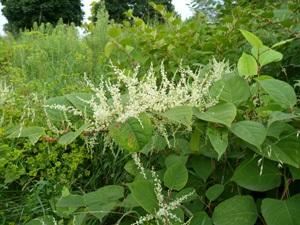Japanese knotweed
The climate is changing and nature is changing with it. Also in the municipality of Wassenaar you notice the consequences. Among other things by the advance of harmful plants such as Japanese knotweed. This persistent plant can cause a lot of damage to your garden and home and also to public spaces. Read how to recognize Japanese knotweed and what you can do to control it.
Japanese Knotweed in public spaces
The municipality keeps track on a Map where the plants are. Have you seen Japanese knotweed in public areas? Please report this using the reporting form. Clearly indicate the location and that it is Japanese knotweed. You can also attach a photo to the report. You can also call the Customer Contact Center at telephone number 14070.
The municipality mows the plants monthly during the growing season. This depletes the plant and prevents further spread.
Survey map
On the Map you can see where Japanese Knotweed, so far, has been seen in Wassenaar.
Japanese Knotweed on private property
Do you have Japanese Knotweed on your own property? Then you can hire a landscaper or fight the plant yourself. A gardener can advise you on this. The municipality will not visit you on site. Detailed advice and testing of control methods can be found in the Probos Foundation Report.

What you need to know about Japanese Knotweed
- Japanese knotweed is an invasive exotic species. An invasive exotic species is a plant, animal or other organism that does not originally occur in the Netherlands, but has nevertheless gained a foothold here, often under the influence of human activity.
- Japanese Knotweed dies off above ground in winter, but blooms above ground from March/April to November.
- The roots go deep (sometimes up to three meters). The stems are green in color with red spots and hollow inside. The stems resemble bamboo.
- Japanese Knotweed grows at lightning speed. First you see small red buds and leaves, and shortly after that the stems shoot out of the ground. In summer, the leaves become fresh green in color and as big as your hand. White flowers appear at the ends of the stems. The plant can grow up to two meters tall.
- Japanese Knotweed is beautiful, but dangerous. It displaces other plants and causes damage to bike paths, asphalt roads and the foundations of buildings and homes due to its enormous growing power. To invade your home, a small crack or hole is all the plant needs.
- Early removal is therefore of the utmost importance. For your own garden and home, but also for public green spaces and outdoor areas.
What you can do yourself to control the plant
- Digging out
Important here is to remove all roots. Even from the smallest piece of Japanese Knotweed a new plant can grow again. - Mow and keep mowing
Is digging out insufficient because the roots are already too deep? Then pull out the stems and then mow as close to the ground as possible. Repeat every two to four weeks and do this for several months. Keep going, especially keep mowing. Mowing exhausts the plant and chances are it will eventually disappear. - Mowing waste = residual waste
It is important that you remove the clippings (not only the roots and plant residues, but also the soil where the Japanese knotweed stood) and dispose of it as residual waste. So not with the vegetable, fruit and garden waste (VGF), but in the container for residual waste. This is because of the danger of the plant spreading further via the GFT.